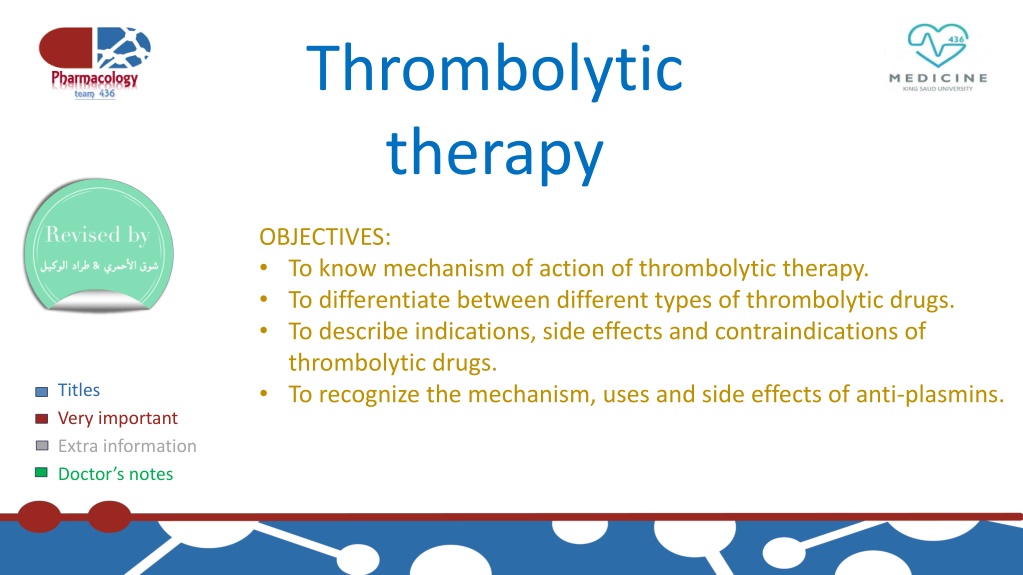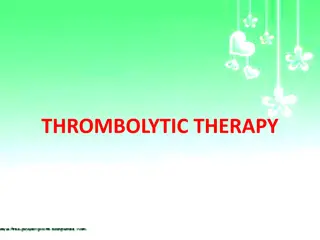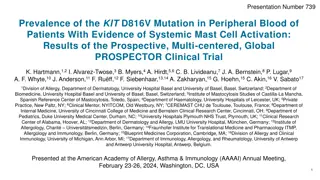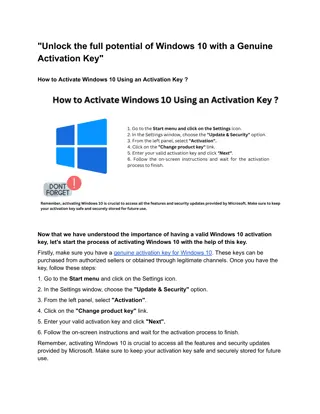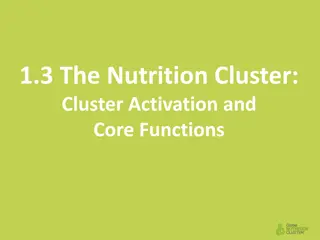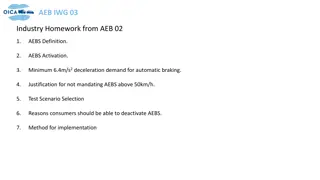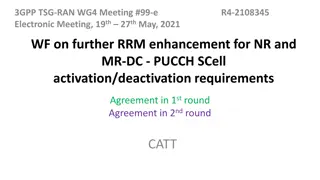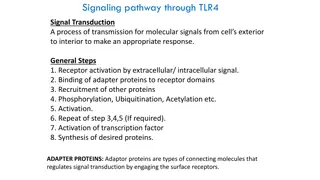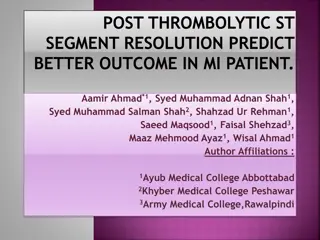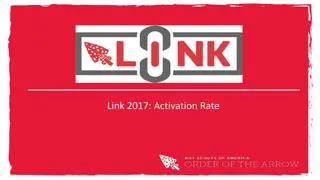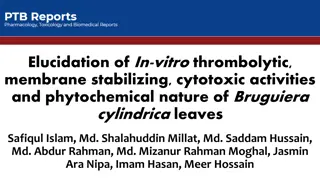Understanding Thrombolytic Therapy and Plasminogen Activation
Thrombolytic therapy involves the use of drugs to dissolve blood clots, with plasminogen activation being a key mechanism. Different types of thrombolytic drugs like fibrin-specific and non-fibrin-specific agents are available, each with varying effects on clot dissolution and systemic plasminogen activation. Understanding the classifications, mechanisms of action, indications, side effects, and differences between these drugs is crucial for successful clinical management of conditions such as ischemia where clot lysis is necessary.
- Thrombolytic therapy
- Plasminogen activation
- Fibrin-specific drugs
- Non-fibrin-specific drugs
- Clot lysis
Download Presentation

Please find below an Image/Link to download the presentation.
The content on the website is provided AS IS for your information and personal use only. It may not be sold, licensed, or shared on other websites without obtaining consent from the author. Download presentation by click this link. If you encounter any issues during the download, it is possible that the publisher has removed the file from their server.
E N D
Presentation Transcript
Thrombolytic therapy OBJECTIVES: To know mechanism of action of thrombolytic therapy. To differentiate between different types of thrombolytic drugs. To describe indications, side effects and contraindications of thrombolytic drugs. To recognize the mechanism, uses and side effects of anti-plasmins. Titles Very important Extra information Doctor s notes
Plasmin: Non-specific protease capable of breaking down: Fibrin. Other circulating factors including: Fibrinogen. Clotting factor V. Clotting factor VIII. Thrombolytic drugs: Drugs used to lyse already formed blood clot in clinical sittings where ischemia may be fatal. Mechanism of action: They have common mechanism of action by stimulating activation of plasminogen via converting plasminogen to pro- enzyme to plasmin active enzyme which leads to lysis of the insoluble fibrin into soluble derivatives. Plasminogen is inactive and found into two forms: Bound with fibrin. (forms the thrombus) In plasma. Plasminogen Lippincott s corner Thrombolytics (Plasminogen activators) All thrombolytic agents act either directly or or indirectly to convert plasminogen, which in turn cleaves fibrin, thus lysing thrombi. Clot dissolution and reperfusion occur with a higher frequency when therapy is initiated early after clot formation because clots become more resistant to lysis as they age. Unfortunately, increased local thrombi may occur as the clot dissolves, leading to enhanced platelet aggregation and thrombosis. Strategies to prevent this include administration of anti-platelet drugs such as aspirin, or anti-thrombotics such as heparin. Plasmin Plasmin is the active form of plasminogen. Insoluble fibrin Soluble degradation products Plasmin lysis the insoluble Fibrin into soluble degradation products. 2
Types of Thrombolytic drugs Fibrin specific Non-fibrin specific (also called tissue plasminogen activators)(t-PA) (ART) (t-PA) Alteplase Reteplase Tenecteplase Anistreplase Streptokinase Urokinase Activate both plasminogen bound to clot surface and circulating plasminogen in blood leading to extensive systemic plasminogen activation, with degradation of several plasma proteins including fibrinogen, factor V, and factor VIII. Fibrin specific plasminogen activators activate mainly plasminogen bound to clot surface and have less effect on circulating plasminogen. 3
Non fibrin-specific thrombolytic drugs Fibrin-specific thrombolytic drugs Fibrin-specific drugs (clot specific). Reduced risk of bleeding. Not-antigenic. Activate plasminogen bound to clot surface and circulating plasminogen in blood. Degrade mainly fibrin clots. )Once they bind to fibrin, their activity is enhanced( Degrade fibrin clots as well as fibrinogen and other plasma proteins. Less selective in action. More selective in action (clot or fibrin specific). Extensive systemic plasminogen activation. Less systemic plasminogen activation. More risk of bleeding. Less risk of bleeding. Streptokinase Anistreplase Urokinase Alteplase Reteplase Tenecteplase 4
Streptokinase Pharmacokinetics: T is less than 20 minutes. Given as intravenous infusion (250,000 U then 100,000 U*/h for 24-72 hours) Streptokinase is a bacterial protein produced by Beta-hemolytic streptococci. Streptokinase is non-fibrin specific. Can degrade fibrin clots as well as fibrinogen and other plasma proteins. *U=unit. Which depends on the patient without a standard doses of ml. It is the least expensive among others. Used for venous or arterial thrombosis. Mechanism of action: Acts indirectly by forming plasminogen-streptokinase complex active complex which converts plasminogen into active plasmin. Side effects: Antigenicity*: high-titer antibodies develop 1 to 2 weeks after use, precluding retreatment until the titer declines. Allergic reaction: rashes, fever, hypotension. Bleeding: due to activation of circulating plasminogen. *Antigenicity means that the immune system will produce an antibodies for this drug so that: The effectiveness of the drug will be decreased after the 1st dose. The drug can cause allergic reactions that can be serious. Not used in patients with: Recent streptococcal infections. Previous administration of the drug. These patients may develop fever, allergic reactions and resistance upon treatment with streptokinase due to antistreptococcal antibodies. 5
Antistreplase (APSAC) Urokinase Human enzyme synthesized by the kidney that can be Obtained from either urine or cultures of human embryonic kidney cells. Anisoylated Plasminogen Streptokinase Activator Complex (APSAC) acylated plasminogen combined with streptokinase . It is a prodrug, de-acylated in circulation into the active plasminogen- streptokinase complex. T is longer 70/120 min. Is a direct plasminogen activator. Given by intravenous infusion (300.000 U over 10 min, then 300,000 U/h for 12h). Has an elimination half-life of 12-20 minutes. Advantages: Given as bolus IV injection. (20 U over 3-5 min.) Longer duration of action than streptokinase. More thrombolytic activity. Greater clot selectivity. There is relationship between the kidney s & lung s enzymes such as in RAAS Used for lysis of acute massive pulmonary embolism. Has NO anaphylactic effect. (Because it s a human enzyme) Disadvantages: o Minimal fibrin specificity. o Systemic lysis (act upon fibrin-bound and circulating plasminogen). o Expensive and its use now is limited. Disadvantages: Similar but less than streptokinase alone in: Antigenicity. Allergic reactions. Minimal fibrin specificity. Systemic lysis. More expensive than streptokinase. 6
Tissue plasminogen activators (t-PA) All are recombinant (combination) of human tissue plasminogen activator. Prepared by recombinant DNA Technology. Includes the drugs that end with suffix PLASE : o Alteplase. o Reteplase. o Tenecteplase. Don t confuse them with Antistreplase. Alteplase Reteplase Tenecteplase Is a recombinant form of human t-PA. Has a very short duration of action 5 min . It s usually administered as an intravenous bolus followed by an infusion. (60 mg IV bolus then 40 mg infusion over 2 hours). Another modified human t-PA. Prepared by recombinant DNA technology. Has t of more than 30 min. Can be administered as a single IV bolus. More fibrin-specific with longer duration of action. Approved only to be used in acute myocardial infarction. A variant of recombinant t-PA. It has longer duration of action (15 min). Has enhanced fibrin specificity. Given as 2 IV bolus injections of 10 U each. (NO INFUSION) Mechanism of action: They activate fibrin-bound plasminogen rather than free plasminogen in blood. There action is enhanced by presence of fibrin. They bind to fibrin in a thrombus and convert the entrapped plasminogen to plasmin followed by activation of local fibrinolysis with limited systemic fibrinolysis. Advantages: Fibrin-specific (clot specific) drugs. Limited systemic fibrinolysis. Reduced risk of bleeding. (Because of the limitation of systemic fibrinolysis) Not-antigenic ( can be used in patient with recent streptococcal infection or even with a previous administration of streptokinase). Both (alteplase and reteplase) of them are used in: In ST-elevation (myocardial infarction). Pulmonary embolism. Tencete for a long period 7
Indication of thrombolytics Acute myocardial infarction. (elevation of ST segment). Acute ischemic stroke. Peripheral artery occlusion. Deep venous thrombosis. Pulmonary embolism. such as Urokinase / Alteplase / Reteplase Contraindication of thrombolytic Absolute Relative Rational for use of thrombolytic drugs in acute MI Improvement of ventricular function. Reduction in incidence of congestive heart failure. Reduction of mortality following AMI. Active internal bleeding. Cerebral hemorrhagic stroke. Recent intracranial trauma. Intra cranial neoplasm. Major surgery within two weeks. Active peptic ulcer Severe uncontrolled hypertension. Thrombolytic drugs need to be administered immediately after diagnosis of MI, delay of administration will be of no value because the clot will be resistant to the drugs and there will be tissue damage What is the role of thrombolytic therapy in antithrombotic plan? The goal of thrombolytic therapy is rapid restoration of blood flow in an occluded blood vessel by accelerating proteolysis of already formed thrombus. Thrombolytic therapy is one part of an over all antithrombotic plan that frequently includes anticoagulants, antiplatelet agents and mechanical approaches to rapidly restore blood flow and prevent re-occlusion. 8
Fibrinolytic Inhibitors (Antiplasmins) inhibit plasminogen activation and thus inhibit fibrinolysis and promote clot stabilization. .. Drug Aminocaproic Acid & tranexamic acid Aprotinin Mechanism Competitive Inhibition of Plasminogen Activation. inhibits fibrinolysis by blocking the action of plasmin (Plasmin antagonist). Administration Orally. Orally or IV. Adjuvant therapy in hemophilia. Postsurgical bleeding. Antidote for Fibrinolytic therapy-induced bleeding. Uses These drugs work like antidotes for fibrinolytic drugs. Similar to Protamine (Antidote of the anticoagulant, heparin) or Vitamin K (Antidote of the oral anticoagulant warfarin). 9
Lippincotts Thrombolytic drugs: Acute thromboembolic disease in selected patients may be treated by the administration of agents that activate the conversion of plasminogen to plasmin, a serine protease that hydrolyzes fibrin and, thus, dissolves clots. Streptokinase, one of the first such agents to be approved, causes a systemic fibrinolytic state that can lead to bleeding problems. Alteplase acts more locally on the thrombotic fibrin to produce fibrinolysis. Urokinase is produced naturally in human kidneys and directly converts plasminogen into active plasmin. compares the thrombolytic agents. Fibrinolytic drugs may lyse both normal and pathologic thrombi. 2. Therapeutic use: Originally used for the treatment of DVT and serious PE, thrombolytic drugs are now being used less frequently for these conditions. Their tendency to cause bleeding has also blunted their use in treating acute peripheral arterial thrombosis or MI. For MI, intracoronary delivery of the drugs is the most reliable in terms of achieving recanalization. However, cardiac catheterization may not be possible in the 2- to 6-hour therapeutic window, beyond which signicant myocardial salvage becomes less likely. Thus, thrombolytic agents are usually administered intravenously. Thrombolytic agents are helpful in restoring catheter and shunt function, by lysing clots causing occlusions. They are also used to dissolve clots that result in strokes. A. Common characteristics of thrombolytic agents: 1. Mechanism of action: The thrombolytic agents share some common features. All act either directly or indirectly to convert plasminogen to plasmin, which, in turn, cleaves fibrin, thus lysing thrombi. Clot dissolution and reperfusion occur with a higher frequency when therapy is initiated early after clot formation because clots become more resistant to lysis as they age. Unfortunately, increased local thrombi may occur as the clot dissolves, leading to enhanced platelet aggregation and thrombosis. Strategies to prevent this include administration of antiplatelet drugs, such as aspirin, or anti-thrombotics such as heparin. 3. Adverse effects: The thrombolytic agents do not distinguish between the fibrin of an unwanted thrombus and the fibrin of a beneficial hemostatic plug. Thus, hemorrhage is a major side effect. For example, a previously unsuspected lesion, such as a gastric ulcer, may hemorrhage following injection of a thrombolytic agent. These drugs are contraindicated in pregnancy, and in patients with healing wounds, a history of cerebrovascular accident, brain tumor, head trauma, intracranial bleeding, and metastatic cancer. 10
B. Alteplase, reteplase, and tenecteplase: Alteplase [AL-teh-place] (formerly known as tissue plasminogen activator or tPA) is a serine protease originally derived from cultured human melanoma cells. It is now obtained as a product of recombinant DNA technology. Reteplase [RE-teh-place] is a genetically engineered, smaller derivative of recombinant tPA. Tenecteplase [ten- EK-te-place] is another recombinant tPA with a longer half-life and greater binding affinity for fibrin than alteplase. Alteplase has a low affinity for free plasminogen in the plasma, but it rapidly activates plasminogen that is bound to fibrin in a thrombus or a hemostatic plug. Thus, alteplase is said to be fibrin selective at low doses. Alteplase is approved for the treatment of MI, massive PE, and acute ischemic stroke. Reteplase and tenecteplase are approved only for use in acute MI, although reteplase may be used off-label in DVT and massive PE. Alteplase has a very short half-life (5 to 30 minutes), and therefore, 10% of the total dose is injected intravenously as a bolus and the remaining drug is administered over 60 minutes. Both reteplase and tenecteplase have longer half-lives and, therefore, may be administered as an intravenous bolus. Alteplase may cause orolingual angioedema, and there may be an increased risk of this effect when combined with angiotensin-converting enzyme (ACE) inhibitors. C. Streptokinase: Streptokinase [strep-toe-KYE-nase] is an extracellular protein purified from culture broths of group C -hemolytic streptococci. It forms an active one-to-one complex with plasminogen. This enzymatically active complex converts un-complexed plasminogen to the active enzyme plasmin. In addition to the hydrolysis of fibrin plugs, the complex also catalyzes the degradation of fibrinogen, as well as clotting factors V and VII. With the advent of newer agents, streptokinase is rarely used and is no longer available in many markets. D. Urokinase: Urokinase [URE-oh-KYE-nase] is produced naturally in the body by the kidneys. Therapeutic urokinase is isolated from cultures of human kidney cells and has low antigenicity. Urokinase directly cleaves the arginine valine bond of plasminogen to yield active plasmin. It is only approved for lysis of pulmonary emboli. Off-label uses include treatment of acute MI, arterial thromboembolism, coronary artery thrombosis, and DVT. Its use has largely been supplanted by other agents with a more favorable benefit-to-risk ratio. 11
Drugs used to treat bleeding: Bleeding problems may have their origin in naturally occurring pathologic conditions, such as hemophilia, or as a result of fibrinolytic states that may arise after GI surgery or prostatectomy. The use of anticoagulants may also give rise to hemorrhage. Certain natural proteins and vitamin K, as well as synthetic antagonists, are effective in controlling this bleeding. Concentrated preparations of coagulation factors are available from human donors. However, these preparations carry the risk of transferring viral infections. Blood transfusion is also an option for treating severe hemorrhage. Adverse effects of drug administration include hypersensitivity as well as dyspnea, flushing, bradycardia, and hypotension when rapidly injected. C. Vitamin K: Vitamin K1 (phytonadione) administration can stop bleeding problems due to warfarin by increasing the supply of active vitamin K1, thereby inhibiting the effect of warfarin. Vitamin K1 may be administered via the oral, subcutaneous, or intravenous route. [Note: Intravenous vitamin K should be administered by slow IV infusion to minimize the risk of hypersensitivity or anaphylactoid reactions.] For the treatment of bleeding, the subcutaneous route of vitamin K1 is not preferred, as it is not as effective as oral or IV administration. The response to vitamin K1 is slow, requiring about 24 hours to reduce INR (time to synthesize new coagulation factors). Thus, if immediate hemostasis is required, fresh frozen plasma should be infused. A. Aminocaproic acid and tranexamic acid: Fibrinolytic states can be controlled by the administration of aminocaproic [a-mee-noe-ka-PROE-ic] acid or tranexamic [tran-ex-AM-ic] acid. Both agents are synthetic, orally active, excreted in the urine, and inhibit plasminogen activation. Tranexamic acid is 10 times more potent than aminocaproic acid. A potential side effect is intravascular thrombosis. B. Protamine sulfate: Protamine [PROE-ta-meen] sulfate antagonizes the anticoagulant effects of heparin. This protein is derived from fish sperm or testes and is high in arginine content, which explains its basicity. The positively charged protamine interacts with the negatively charged heparin, forming a stable complex without anticoagulant activity. 12
Team leaders : Rawan Alqahtani Alanoud Alsaikhan Allulu Alsulayhim Anwar Alajmi Ashwaq Almajed Atheer Alrsheed Jawaher Abanumy Laila Mathkour Maha Alissa Najd Altheeb Rana Barasain Reem Alshathri Sama Alharbi Shoag Alahmari Shrooq Alsomali Abdulrahman Thekry Ghadah Almuhana Editing file Team members: Abdulaziz Redwan Khalid Aleisa Omar Turkistani Faris Nafisah Mohammed Khoja Abdulrahman Alarifi Abdulrahman Aljurayyan Moayed Ahmad Faisal Alabbad Contact us : @Pharma436 Pharma436@outlook.com
